where's the simplest drama located ?'
 The National Geographic Channel is known for high-quality nature shows, non-fiction programs and factual documentaries, including those with a focus on history. Some 74% of all households in the US with televisions have NatGeo available for viewing. With such a wide potential reach, and carrying the imprint of the highly respected National Geographic Society, NatGeo is usually a welcomed oasis for those criss-crossing the vast arid tracts of The Great TV Desert.
The National Geographic Channel is known for high-quality nature shows, non-fiction programs and factual documentaries, including those with a focus on history. Some 74% of all households in the US with televisions have NatGeo available for viewing. With such a wide potential reach, and carrying the imprint of the highly respected National Geographic Society, NatGeo is usually a welcomed oasis for those criss-crossing the vast arid tracts of The Great TV Desert.
NatGeo's new series, American Genius - with a snappy and appealing web presence - is supposedly a broad historical and factual sweep of technical development in the US, posed as the product of fiercely competitive quasi-industrialists/inventors. With mini-series titles "Edison vs Tesla," "Jobs vs Gates," "Farnsworth vs Sarnoff," "Hearst vs Pulitzer," "Colt vs Wesson," "Oppenheimer vs Heisenberg," "Space Race," and "Wright vs Curtiss" it promised to be an engaging series of fascinating history.
According to the National Geographic Channel, its American Genius "documentary" series
"... chronicles the competitions in innovation that pitted history's brightest minds against each other in the race to lay claim to the future. From Steve Jobs vs. Bill Gates to the Wright Brothers vs. Glen [sic] Curtiss, each episode of the show focuses on a specific rivalry, delving into the fierce power struggles, deceit, fluke timing, and raw ambition out of which innovation was born. Iconic masterminds pushed themselves to the limits of human genius, overcoming equally brilliant and ruthless competitors to turn history's greatest ideas into reality."
The National Geographic Channel suggests that we...
"Use this collection of educational content to delve deeper into relevant history and geography topics and the show's main themes of competition, innovation, and failure as a critical part of success."
However, there's trouble "Right Here in River City" - if "Wright vs Curtiss" is any indication, this will be a deeply flawed series that will become known more for its lack of direction and absence of historical facts, than for truth.
As for delving "deeper into relevant history" - the viewer would do much better to turn off the flatscreen and open a true book of history, such as the magnificent The Bishop's Boys, A Life of Wilbur and Orville Wright by Tom Crouch, Miracle at Kitty Hawk by Fred C. Kelly, Wilbur and Orville by Fred Howard, Visions of a Flying Machine by Peter L. Jakab, The Wright Brothers by David McCullough, or The Papers of Wilbur and Orville Wright compiled by Marvin W. McFarland.
Apparently the production team and writers working at Banijay Group/Stephen David Entertainment (producers of the NatGeo American Genius series, as well as the History Channel's The Men Who Built America series recently aired) failed to crack open any serious history books and instead relied on the flawed and seriously biased works of Seth Shulman and Lawrence Goldstone, who both produced books on early flight that displayed an overabundance of bias, especially anti-Wright brothers bias.
The source for much of the warped portrayal of Wilbur Wright in this series can be traced to Goldstone's book...
"... the demons that caused Wilbur Wright to abandon science, to eschew innovation, to embark on a hopeless crusade to vanquish foes real and imagined, robbed him of decades of his life and America and the world of one of its exceptional intellects. That the tragedy of Wilbur's fall was self-generated makes the irony only that much more cruel."
The only great irony here is that Goldstone seems to ignore the fact that Wilbur Wright's towering intellect gave birth to the airplane. As for Wilbur being "robbed of decades of his life..." Wilbur died in 1912 at the age of 45, so exactly which decades was he robbed of by "the demons" ? ... and when did Wilbur "abandon science" and "eschew innovation" ? ... and note to Goldstone - it wasn't mythical demons that caused Wilbur's death, it was typhoid.
Wilbur accomplished what he most wanted to do with his life, he, with Orville's assistance, solved the monumental problem of powered, sustained, controlled, heavier-than-air, human flight.
What more would Goldstone have wanted to demand of him ?
Does Goldstone believe that Wilbur and Orville Wright should have abandoned their patent ?
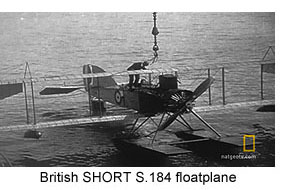 The wrong-headed use of film of a British Short S.184 floatplane while commenting on Curtiss and his flying boats, a skewed and uniformly negative view of the Wright brothers, the liberal use of modern phrases and words such as "airplane" (in place of the historically correct and then universal term "aeroplane") make it even more difficult to take "Wright vs Curtiss" seriously.
The wrong-headed use of film of a British Short S.184 floatplane while commenting on Curtiss and his flying boats, a skewed and uniformly negative view of the Wright brothers, the liberal use of modern phrases and words such as "airplane" (in place of the historically correct and then universal term "aeroplane") make it even more difficult to take "Wright vs Curtiss" seriously.
Then there is the dramatic moment when Henry Ford arrives at Curtiss' workshop in Hammondsport, New York, to offer help in the Wright vs Curtiss patent suit... however, there's a problem - it was Curtiss who visited Ford, at Detroit, not the other way around... another indication of this series' sloppiness.
With the use of Mr. Shulman as an "expert," we can be certain to be subjected to over-fictionalized dramatic events and wholly invented dialogue, inner and interpersonal. Shulman has also demonstrated a decidedly negative disposition toward Alexander Graham Bell, who, in addition to inventing the telephone, founded the "Aerial Experiment Association" (A.E.A.), a "co-operative scientific association" that counted Glenn H. Curtiss among its members in 1908.
So, it's doubly odd that NatGeo would be content to have Shulman involved in this production, considering that Bell's father-in-law, Gardiner G. Hubbard, was the first president of the National Geographic Society.
It's difficult to know where to begin with the great array of mistakes and historical errors adorning the website's episode clips and the trailers... but here are a few that will cause teeth grinding and palpitations to informed history buffs (as they prepare to make lunging grabs for their remotes)...
The theme of failure leading to success is portrayed by a crash that happened in 1901 while Wilbur Wright was gliding with the 1901 Wright glider... the problem is the machine shown is the 1902 Wright glider, and compounding that error, the crash is moved to 1902... for dramatic effect ?... sloppiness ?... for whatever reason, it isn't factual and it isn't history. It therefore also misses a key element in the development that led to the 1903 Wright Flyer.
But that's not the only time-warping "Wright vs Curtiss" indulges in... the Wright wind tunnel tests during the fall of 1901, which led to the elegant 1902 Wright glider and ultimately to the successful 1903 Wright Flyer, are placed in 1902, rather than in 1901. Such time-shifting might seem inconsequential, however, it demonstrates that those involved in the production of "Wright vs Curtiss" were only superficially aware of the story they were telling... or that they valued dramatic effect over factual history... or both.
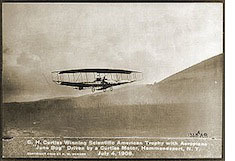 "Wright vs Curtiss" makes a big to-do about who made the "first public flight" - and hands that prize to Glenn Curtiss, for his wintertime 1908 flight in the A.E.A.'s June Bug biplane.
"Wright vs Curtiss" makes a big to-do about who made the "first public flight" - and hands that prize to Glenn Curtiss, for his wintertime 1908 flight in the A.E.A.'s June Bug biplane.
The series narrator (Ray Liotta) tells us in a "Tale of Two Rivals"...
"The Wright Brothers build and fly the world's first airplane, but they keep it a secret, leaving an opening for motor designer, Glenn Curtiss, to swoop in and compete to be the first to fly in public."
However, as with much of "Wright vs Curtiss" the truth is something else. In January 1908, when A.E.A. member Lt. Thomas Etholen Selfridge wrote to the Wrights seeking essential technical information, the Wrights promptly responded with material and referenced published sources that permitted the A.E.A. members to produce powered machines that flew.
Furthermore, the recognition for the first truly public flight (not the first flight) should go to Alberto Santos=Dumont, for his Parisian flight in the 14-bis in November 1906. Wilbur and Orville Wright made the effort to make a public flight, in front of a group of reporters, in 1904, but were unable to due to engine trouble and weather.
Late in 1905, Wilbur and Orville were making circling flights of up to 24 miles, at Huffman Prairie, near Dayton, in full view of anyone who was paying attention.
NatGeo's "Wright vs Curtiss" tell us, erroneously,...
"Despite Orville Wright's pleas to his brother to prove to the world they have working airplanes, Wilbur fiercely protects his planes, working obsessively on design and guarding his patents and less on promoting the field of aviation through publicized flying demonstrations."
There is a total absence of evidence to support the series' contention that there was disagreement between Wilbur and Orville Wright about whether or not to make public flights. That element of "Wright vs Curtiss" is wholly fabricated.
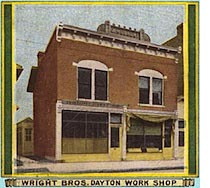 Many relevant people and items seem to be missing from "Wright vs Curtiss," including Octave Chanute, Augustus Moore Herring, Bishop Milton and Katharine Wright, Charles E. Taylor, "Uncle" Tom Baldwin, the 1905 Wright Flyer (the first practical aeroplane), the small Wright Bicycle Co. shop (replaced with a fantasized large warehouse), and... and... and...
Many relevant people and items seem to be missing from "Wright vs Curtiss," including Octave Chanute, Augustus Moore Herring, Bishop Milton and Katharine Wright, Charles E. Taylor, "Uncle" Tom Baldwin, the 1905 Wright Flyer (the first practical aeroplane), the small Wright Bicycle Co. shop (replaced with a fantasized large warehouse), and... and... and...
"The Wright brothers have locked Glenn Curtiss in a brutal patent suit, bringing their rival to the brink of bankruptcy."
Curtiss didn't lack for financial support in the patent cases and the only "bankruptcy" involved was the one precipitated by Curtiss to rid himself of his irksome business partner Augustus Moore Herring, to eliminate the Herring-Curtiss Co., which had become a nightmare.
Again and again, "Wright vs Curtiss" chooses simplified drama over more complicated facts and historical truth.
If ever someone wondered why Wilbur and Orville Wright ended up conducting their aerial experiments at Kill Devil Hill, North Carolina, "Wright vs Curtiss" has an answer...
"Wright vs Curtiss" "expert" Lawrence Goldstone comments...
"Wilbur recognized that you needed to fly in wind. He said no bird soars in a calm, and they were looking for some place where it was sandy, so if you landed you wouldn't get killed."
Of course, that answer is wrong, but it has the merit of demonstrating just how goofily essential elements are treated in "Wright vs Curtiss." Obviously, at the end of each flight, whether in a glider or a powered machine, there would be a landing of some sort, whether a hard crash or a soft descent. He seems to say that landing on anything other than sand would kill the machine's operator... at a minimum he is being inarticulate. Was the presence of sand the essential thing to Wilbur and Orville Wright ? No, the choice of Kill Devil Hill/Kitty Hawk, had primarily to do with steady prevailing winds, the secluded nature of the location and the fact that sand would, to some degree, buffer a fall, which was Octave Chanute's suggestion.
 The actor portraying the over-dramatized and under-aged Wilbur tries to do an earnest job, but is burdened with an impossible mischaracterization of Wilbur as a semi-fanatical older brother - the blame for that gross mischaracterization rests solely on the shoulders of the production company and NatGeo.
The actor portraying the over-dramatized and under-aged Wilbur tries to do an earnest job, but is burdened with an impossible mischaracterization of Wilbur as a semi-fanatical older brother - the blame for that gross mischaracterization rests solely on the shoulders of the production company and NatGeo.
The Wilbur Wright of this series is unrecognizable to most aviation historians, an obsessive, secretive, domineering older brother bent on protecting "his planes" and "his patents" - actually jointly held by Wilbur and Orville - a persona concocted to create dramatic tension between Orville and Wilbur.
The odd depiction of Wilbur Wright in "Wright vs Curtiss" has its roots firmly planted in Goldstone's book.
The narrator of "Wright vs Curtiss" states...
"Wilbur Wright, an intense, determined bicycle mechanic from Ohio, discovers the key to human flight: wing warping - the subtle dip and rise that birds take to maintain balance."
Of course, they couldn't even get that right... Wilbur was not only a "bicycle mechanic" - he and his brother were bicycle manufacturers, and what in the world does "Wright vs Curtiss" mean by "the subtle dip and rise that birds take to maintain balance." - is the program saying that the balance of a bird or an aerial vehicle is dependent on going up and down ? Nonsense...
The "Wright vs Curtiss" false version has Wilbur as a snarky elitist who has this to say about Glenn Curtiss...
"Mr. Curtiss is a man who shows no respect, for himself, for others, for the courts of law. When you're dealing with a man like that, not much you can do, other than keep going."
This is in stark contrast to the "Wright vs Curtiss" version of Glenn Hammond Curtiss...
The "Wright vs Curtiss" version of Glenn Hammond Curtiss - a patient, humble, generous soul who "prefers" motorcycles - says...
"I didn't need to be the first man in the air. I prefer to be on the ground. I prefer a motorcycle. I prefer wheels on the earth... and I have my business, Curtiss Engines... and this is only speculation but I feel as though, perhaps, the Wright brothers were compelled to work inwards because this is what they had. They felt destined to be the first in flight. I was fascinated, I was compelled, but I didn't feel it was my purpose on earth."
"Wright vs Curtiss" tells us...
"The Wright Brothers' rival, Glenn Curtiss, has none of their restraint. He's a pioneering motorcyclist, a go-getter, and he seizes on the challenge of flight with another design for balance - ailerons, the flaps we use on airplane wings today."
Notice the program botches the distinction between "flaps" and "ailerons" - was that too deep a mystery for the "Wright vs Curtiss" crew to figure out ? Also, the matter of balance, so far as "Wright vs Curtiss" is concerned, seems to be limited to lateral balance only, yet as any budding aviator knows, aeroplanes require three-axis control, not solely lateral (roll) control.
For some remarkable reason, the "Wright vs Curtiss" program cannot even manage to use the correct names of Curtiss' companies, which were "Curtiss Aeroplane and Motor Company" and "Curtiss Motor Co" - not some imaginary "Curtiss Engines."
This degree of sloppiness is simply unforgivable.
Notice too, that the "Wright vs Curtiss" version of Curtiss emphasizes the program's theme that the Wrights were "obsessed" - but the likeable personable Glenn Curtiss of the program is almost sympathetic to the plight of the Wrights because in his view they have nothing else in life... "They felt destined to be the first in flight."
Wilbur and Orville Wright worked their tails off developing their machines, industrious to a remarkable degree, scientific and with a remarkable sense of invention, not some half-crazed semi-fanatics scrapping and scratching to be the "first in flight."
"Wright vs Curtiss" pushes the false narrative that the truly heroic figure in all this was Glenn Curtiss, and the Wrights were responsible for the lagging aviation industry in the US. In this writer's view, the Wrights and Curtiss and all the others pursuing flight through the centuries were heroic, complete with quirks and flaws.
The program's collegial version of Curtiss has this to say about his relationship with the Wrights while pushing the program's theme that the Wrights were responsible for the suppressed aviation industry in the US...
"I would have preferred collaboration, but if I were to choose a rival I would have preferred a more straight forward fight.
"During this never-ending court battle, I was not only bleeding out, but the entire aviation industry, [unintelligible] over the idea of aviation, was stopped."
The true reason why aviation in the US lagged behind Europe after 1910/1911, was that the imperial nations in Europe knew war was coming and their governments invested enormous sums supporting development of aeroplanes and aeroplane manufacturers, while the US government was tight with the pennies, barely giving any support to domestic development of aeroplanes and an aviation industry.
Unfortunately, the "experts" attached to this production apparently would rather indict Wilbur and Orville Wright with impeding aviation in the US, than recognize the historical truth.
"Wright vs Curtiss" perpetuates another old and tired error by wrongly portraying "wing-warping" as the stand-alone invention of Wilbur and Orville Wright. The three-axis control system invented by Wilbur and Orville Wright that was the basis of their patent of 1906.
The 1906 patent was not limited only to "wing-warping," although "wing-warping" (including ailerons and all methods of altering airflow to change or maintain the lateral balance of an aeroplane) was covered as part of their patented three-axis control system. The validity of the 1906 Wright Patent was upheld twice in US Federal District Court.
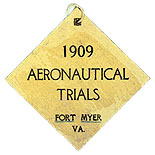
"Wright vs Curtiss" wanted to have conflict between Wilbur and Orville Wright, undoubtedly for dramatic effect, so when they could find none, they made it up.
"Wilbur Wright reluctantly allows Orville to give a flight demonstration to the US War Department, in an attempt to reclaim their title as aviation pioneers."
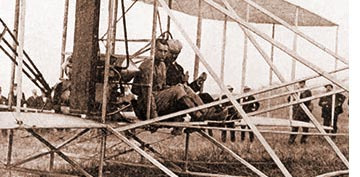 The flights by Orville Wright at Fort Myer, Virginia, in 1908 and 1909, were not simply a "demonstration to the US War Department," they were conducted as performance acceptance trials, to meet the specifications for aerial vehicles that had been issued by the US Army Signal Corps. The competition to meet the specifications for aeroplanes was open to all who cared to compete, in the end only the Wrights entered.
The flights by Orville Wright at Fort Myer, Virginia, in 1908 and 1909, were not simply a "demonstration to the US War Department," they were conducted as performance acceptance trials, to meet the specifications for aerial vehicles that had been issued by the US Army Signal Corps. The competition to meet the specifications for aeroplanes was open to all who cared to compete, in the end only the Wrights entered.
There was no need for the Wrights to "reclaim their title as aviation pioneers" - after the spectacular flights in Europe by Wilbur during August 1908, there was no doubt of their status.
Highly speculative - even fabricated - motivations for the main characters is a hallmark of the "Wright vs. Curtiss" production, and likely is on display in other stories of the American Genius series, and it's this fact that places "Wright vs Curtiss" in the realm of the graphic novel, a comic book version of reality.
"Wright vs. Curtiss" has chosen to tell a simple, less complicated, highly-fictionalized version of reality, rather than the factual historical truth - choosing concocted drama over reality.
That is the central assault on history by the people involved in producing "Wright vs Curtiss," and by NatGeo for airing this program. Many people will watch this distortion of reality and believe it whole hog, every jot and tiddle, because it is a NatGeo program... that is a truly awful thing.
We should all expect this NatGeo series to be accurate and factual, rather than the pared-down, spare, thin, fact-mangled, time-warped, eye-candy product they've given us.
Toys come with warning labels, so should American Genius "Wright vs Curtiss."

